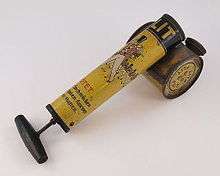Flit gun
A Flit gun is a hand-pumped insecticide sprayer used to dispense FLIT, a brand-name insecticide widely used against flies and mosquitoes between 1928 and the mid-1950s. Although named after the well-known brand, "Flit gun" became a generic name for this type of dispenser.[1] Once commonly found in households, hand-operated Flit guns have been replaced by aerosol spray cans and fallen out of common use.

Design description
A Flit gun consists of a pneumatic pump cylinder with a hand-operated piston to force air through an air nozzle in the front. Below the front of the pneumatic tube hangs a cylindrical container which acts as a reservoir for liquid insecticide, this reservoir being set at 90 degrees to the pneumatic tube. In early versions, the reservoir is permanently secured to the pump and equipped with a removable, gasketed screw cap for filling. In later, improved versions, the insecticide reservoir is secured to the pump with a coarse screw fitting and a seal of cork composite or gasket paper, so that it can readily be unscrewed for filling. A siphon tube extends from the pump cylinder downward into the reservoir and the upper end of the siphon is positioned in front of a nozzle on the air pump. When a jet of high-velocity air exits the pump and streams across end of the siphon tube, it lowers the pressure in the siphon (Bernoulli's principle), drawing insecticide upward from the reservoir, which then atomizes the liquid as it is entrained in the air jet (it is an atomizer nozzle). With each vigorous forward stroke of the pump handle a burst of spray is produced, similar to that of a modern aerosol spray can.
Uses in popular culture
- In 1927, Dr. Seuss gained wider exposure after one of his cartoons in the magazine Judge featured Flit, eventually securing Seuss a 17-year ad campaign for the company, which supported his family through the Great Depression.[2]
- In the 1930 Marx Brothers film Animal Crackers, Harpo Marx pours a chloroform-like substance into a Flit sprayer. Although the movie apparently didn't secure rights to show the Flit logo on-screen (the words "FLIT" on the sprayer are colored over directly on prints of the film), Flit used its appearance in the film for its print advertising, in an early example of film tie-in advertising.[3]
- In Ernest Hemingway's 1938 short story, "The Butterfly and the Tank", the central character uses a flit gun to spray patrons of a bar in Madrid with Eau de Cologne during the Spanish Civil War, setting off a melee that ends poorly.
- In Roald Dahl's 1972 book Charlie and the Great Glass Elevator, the spray for aging was delivered in a Flit gun while in Minusland in the 3rd edition with Quentin Blake's illustrations.
- In the second prologue of Stephen King's 1979 book The Dead Zone, Gregory Stillson uses a Flit gun to spray ammonia in the face of a farm dog, establishing Stillson as the book's villain.
- Stanley, the main character in the 1983 videogame Donkey Kong 3, sprays insecticide from a Flit-style sprayer.
- Schwartz, a character in the 1983 American Christmas comedy film A Christmas Story, tells his friends Ralphie and Flick on their way to school that he's getting his Old Man a Flit gun for Christmas.
References
- Will Allen (2008). The War on Bugs. Chelsea Green Publishing. p. 110. ISBN 978-1-933392-46-2.
- "The Advertising Artwork of Dr. Seuss". Archived from the original on 24 February 2017. Retrieved 2018-10-20.
- Jeffrey Vance (film historian) (October 18, 2016). Animal Crackers audio commentary (Blu Ray). Universal Pictures Home Entertainment.